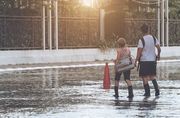Forget Florida, baby boomers are increasingly trekking to countries where adventure trumps relaxation. African safaris, Amazon excursions and Asian discoveries: these are the new favorite destinations of people ages 55 to 64, travel insurance companies report.Not only are they shunning traditional sunspots, but baby boomers are also changing their travel habits. “Instead of jetting off once a year for six months, they are now taking several trips two to three months long,” says François Morel, travel insurance expert at Desjardins Insurance.
This Canadian trend is mirrored on the global scale, says Marc Giguère, vice-president of Intrepid 24/7, part of the Ingle International group. Baby boomers are showing a growing interest in destinations like Peru, South America and Asia. “People are going on African safaris at later and later ages,” Mike Vallee, senior manager for Intrepid 24/7, observes.
Longer life expectancy
Robin Ingle, president of Ingle International, says, “Ten years ago, seniors flocked to Florida and would lounge on the beach with their friends. Today they’re taking cruises, and discovering Cuba, Europe, Mexico and beyond.” He attributes this phenomenon to seniors’ lengthening life expectancy. “They’re more active than ever. They’re living longer and want to see something new,” he says.
Generally, Canadians are more inclined to vacation abroad than Americans. “Nearly 70% of Canadian travellers take trips outside the country, compared with only 30% of Americans,” Ingle says. He adds that destinations like Disney World are very popular with American vacationers. In contrast, Canadians and Quebecers prefer destinations like Cuba, Ingle noted at the International Conference of the NAFA Fleet Management Association.
While the latest figures from the Conference Board of Canada show that 70% to 75% of the general public buys travel insurance before a trip, only 51% of young people do so. “The problem is really their reckless attitude. Efforts must be made to educate them. It is a real challenge for the industry,” François Morel explains. In fact, the monetary aspect is not really an obstacle to buying a policy, he continues, because young people have fewer health problems so it costs them less to get insured.
Isabelle Forget, vice-president at RBC, shares this view. “There is still a lot of confusion and ignorance about different types of travel insurance. Young travellers should not only understand the importance of travel insurance, but also need to be educated about the types of coverage available,” she says.
Young people who take extended stays abroad are more inclined to get insurance, Morel points out.
Marc Giguère agrees, noting a growing enthusiasm among youth for adventure travel, like the baby boomers. This zest for excitement increases the probability that young people will have to show proof of insurance, Mike Vallee points out. “Take Kilimanjaro, for example. No one can climb it without providing proof of insurance.”
Student travel and organized stays are also mushrooming. “For this type of trip, the organizers absolutely need insurance,” Giguère says.
Robin Ingle also adds that there has been an increase in youth-oriented humanitarian projects abroad.
Although some are struggling to attract young clients, others like Colibri seem to have found the key to success: online applications. “For Colibri, the 29 and under market is really growing. Today, young self-employed workers shop online, and this applies to travel insurance as well. We sell a lot online,” says Luc Lavigueur, president of Colibri.
The travel insurance brokerage firm founded in early 2014 lets people ages 29 and under buy insurance policies online from A to Z. Customers can also complete their transactions on smart phones. “Nearly 80% of online sales are done on the computer, but a growing number of people use the mobile application,” Lavigueur says. However, older people cannot complete all the steps online. “Because of the more complex health files for snowbirds,” he explains.
At Desjardins, online transactions are also taking off, François Morel confirms. Less and less insurance is being sold at a branch: 30% of people buy their insurance policies by telephone and 29% online. Although Desjardins lets all its clients complete the procedures from the comfort of their own home computer, Morel points out that older people generally begin the process online and finish by telephone. “The portion corresponding to the health questionnaire generally leads older people to call us to finish it up,” he says.
RBC has seen an increase in online sales for all age groups, Isabelle Forget says.
Ingle International not only has an online presence, but its websites are also optimized for mobile phones. The CEO even has his own blog.
“Our online presence spurs sales, but the main goal of the organization in this 2.0 approach is really to inform people and demonstrate our expertise,” Marc Giguère says. Customers can complete all their transactions online, a service that is being used more and more, he adds.
Mobile applications
Travellers to exotic countries usually need information about the destination before and during the trip. Travel insurance companies have responded by creating mobile applications that provide customer assistance service.
“People were asking many questions. There was a real demand that we go beyond simple travel insurance. This drove us to create the travel assistance service and eventually the website Destinago.com,” Morel of Desjardins, explains. These platforms are quickly catching on.
From anywhere on the planet, insured can get information about their destination in their own language on their smart phone. All thanks to insurance companies who partner with an assistance service.
This practice should proliferate, even among baby boomers and seniors. Currently at 30%, the proportion of people ages 65 and over with smart phones should rise to 40% this year, Deloitte predicts. This means that the retired jetsetters of tomorrow can confidently conquer the exotic destinations of their dreams, armed with their smart phones.








